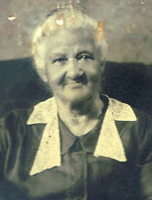
THE ALLEN-BREAUX PAGES
ALLENDOM
Part Two
A Brief, Unfinished History Of The Allen-Breaux Family Written For The 1990 Allen Family Reunion
© 1990
Betty Charbonnet Reid Soskin
Ruth Romine Warnie Strange
Leontine ("Mamma")
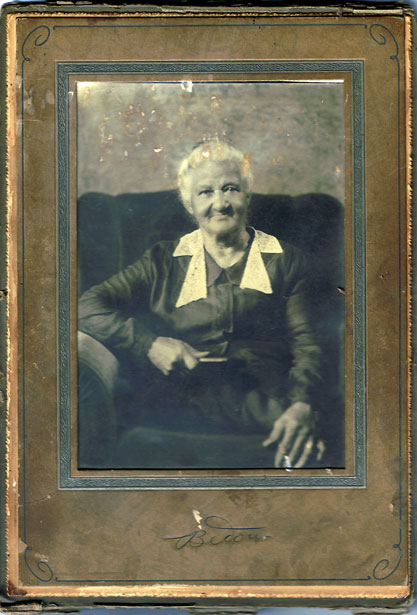
Portrait of Leontine Breaux Allen by famed New Orleans photographer Arthur P. Bedou (photograph courtesy Judith Wilson from the collection of Elaine Allen Wilson)
Remembered
affectionately as our "Mamma," Marie Leontine is our most recent connecting link,
genetically, and the person who is still actively remembered by presently-living
family members. She is still dearly loved and influential within the family structure.
According to church records, Mamma was born on February 7, 1846, and was christened
in October of that same year. These dates are important since they contradict later
entries. We have chosen to accept the church records as valid since other dates are
more subject to human error and depend upon memory. The dates given in census documents
vary by five years in some cases. Since she lived from 1846 to 1948, she was l02
at the time of her death.
It has been said that Mamma was "five-years-old on the Day of Emancipation." However,
if we are to accept the church records as authority, she would have been nineteen
on that day.
This also means that where the census record of 1870 gives her age as twenty-one,
she would actually have been twenty-five.
This means that she spent all of her adolescent years As a child of a slave parent
in the time of slavery, but seems not to have lived the life of a slave. A paradox?
This also means that her parents, Celestine and Edouard married at the point when
freedom was awarded and that she knew and loved her father as a functioning parent.
In a lovely bit of oral history handed down through the years we learn that she met
the man she was to later marry, George Allen, when she was sitting high in a pecan
tree watching the Federal (Union) soldiers marching down the road in St. James. It
is said that he lifted her from the tree and marched with her perched upon his shoulders!
The young couple married and settled down in the little farmhouse
many of us still remember. They lived there along the banks of the Mississippi with
another young couple, the Carrs. According to the census data of 1870, George was
at that time working as a cook and Mamma is listed as "keeper of the house." Thomas
Carr was employed as a coachman while his wife, Lucy, like Leontine, was also listed
as a housekeeper. It is probably safe to assume that the two young women were primarily
responsible for the farming while the husbands worked away from home. This, then,
would be where Mamma became the expert farmer who was able to support her extended
family in later years after George's death.
The two young couples apparently shared these living arrangements until their children
began to arrive.
Together, George and Leontine produced a family of 13 living children. Though George
died a fairly early death (by today's standards), Mamma managed to rear all of her
own family and at least 20 others during her long lifetime. She fed, clothed and
educated them to the best of her ability -- and -- on an army widow's pension of
$90 per month.
Vivian speaks with wonder of how she organized that crew of children of all ages
to work the farm, harvest the crops, prepare the meals, clean the little house, etc.,
etc., etc. In addition it is known that she was the village midwife and "relief"
physician as well. She delivered a host of children in her small community. She seems
to have delivered many of her grandchildren as well.
One of my own favorite stores about Mamma and her life in St. James has to do with
this aspect of her life: Despite her inability to read or write, she acted as an
"intern" to the physician who serviced St. James Parish. It seems that he was a kind
of "circuit rider" who covered about twelve miles each day. According to custom,
each household having someone needing medical attention would place a white towel
on the gate as a sign of medical distress.
Despite her inability to read or write; her expertise in matters of medicine and
healing was such that Dr. Hymel (white) stopped in to see her on his rounds and briefed
her on the cases in her village. It was she who acted as his Nurse Practitioner and
was the person he referred patients to in his absence. Incredible!
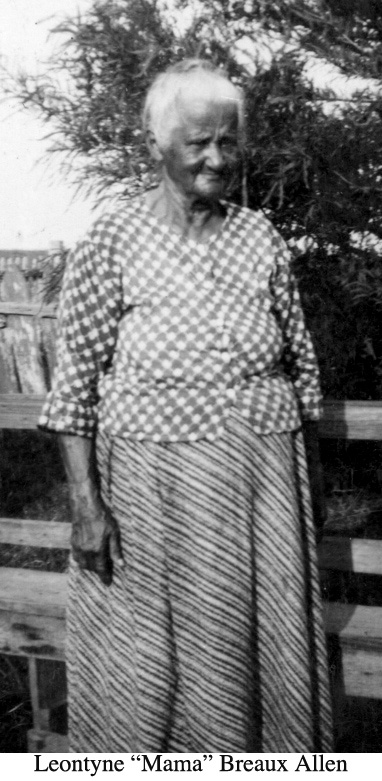 Leontine is said to have been a tiny lady with waist-length dark hair and an even
disposition. She also is said to have been relatively easy-going but "sassy" and
well able to hold her own when the occasion demanded. She spoke only French, the
language of St. James and her times and place. Though her children became bilingual
and spoke both "creole" (a patois of French) and English.
Leontine is said to have been a tiny lady with waist-length dark hair and an even
disposition. She also is said to have been relatively easy-going but "sassy" and
well able to hold her own when the occasion demanded. She spoke only French, the
language of St. James and her times and place. Though her children became bilingual
and spoke both "creole" (a patois of French) and English.
My mother tells of a time when she was a little girl and (apparently) stole an apple from the local fruit vendor. When he descended upon the family in rage,
Mamma faced him with eyes flashing, hands on hips and in absolute defense of the
guilty child shouted, "...when she shits the money, I'll pay for the fruit!"
English must have come with the advent
of soldiers from the northern states and was probably to be attributed to George's
appearance into the life of St. James. Wish our generation had not lost the ability
to speak in creole; the language disappeared with our parental generation.
"Mamma Stories" are endless, fascinating and contradictory. Vivian remembers that
she always walked barefoot (except for church) while Lottie recalls her gaiters (low
black slip on shoes with elastic inserts at the sides).
Lottie remembers how Mamma saved up enough money to buy a buggy from the Sears and
Roebucks Catalog and how radically this changed the family's social life by making
it possible for folks to ride to church in style and to visit surrounding townspeople
from time to time. Until that time visiting was done on horseback and was limited
by the numbers of potential visitors and the scarcity of steeds.
In a conversation with Vivian recently, she mentioned the seven large pecan trees that
surrounded the little house. She said that it was the job of the children to gather
the pecans each season, sack them for payment for the annual property tax assessment.
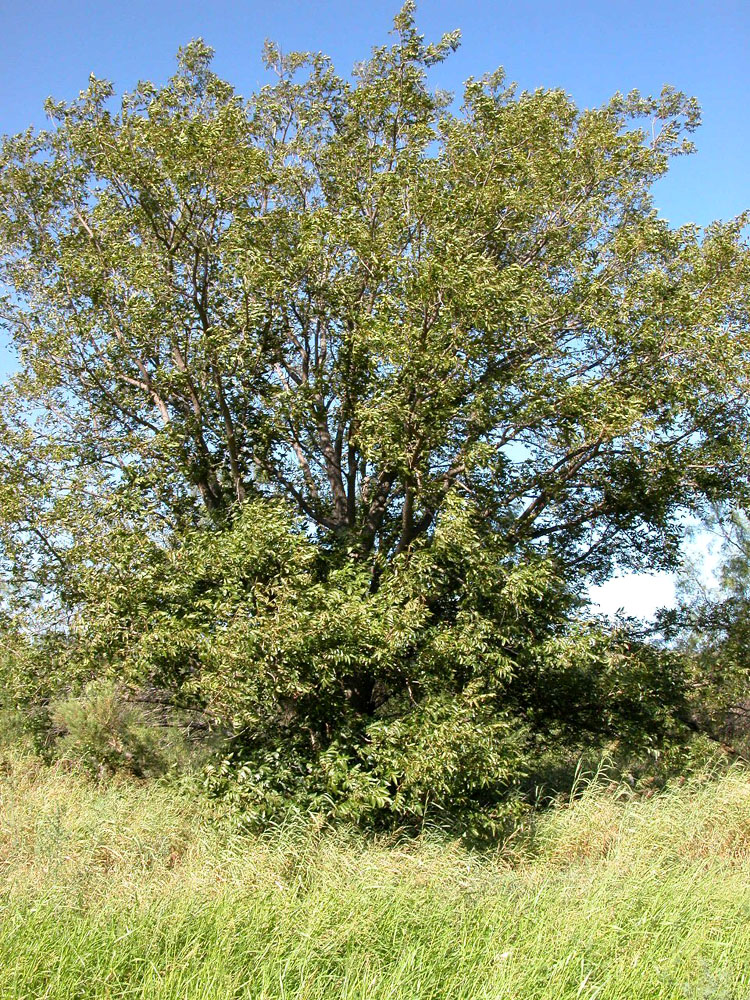
Louisiana pecan tree
Vivian also remembers with a smile how Mamma would send her to the store (in secret)
with a nickel to buy just a bit of tobacco—which she would then secret in the pocket
of her apron and stash in the andiron of the fireplace for Mamma to bring out later
in the evening when everyone was in bed. Her pipe was never smoked in the presence
of the children; she never smoked during the day or in public, "coarse women to that!".
And the excitement when Aunt Camille purchased the player piano for the family! And
how they sat around on Sunday evenings when Mamma "pumped" the piano while Aunt Alice
sang "Ave Maria!"
Wish we could get all of those tales on tape while we still can. Take the time, cousins,
take the time!
Watched Vivian's face light up the other evening when she got to talking about popcorn
balls around the fire, roasting yams in the grate. And "...the barrel of syrup, sack
of rice, sack of sugar when the government check came ...."
Having seen that little farmhouse some years ago while on a visit to the South, it
is almost impossible to imagine how all of those children—all those families—managed to live in that tiny space—under that little roof in St. James. But one
gets the feeling that there was a lot of love spread around and much of it still
lingers in the voices of those who still remember.
In the case of my own grandfather, George Allen, III; he married my grandmother,
Minétte, when she was a mere fourteen. She lived for a brief period and died
when my mother, Lottie, was a tiny seven-month-old baby.
George was Mum's oldest son, and when he returned home to deliver his tiny baby, Lottie
was added to the family just a little older than her own baby, Camille, who was two
and who was shortly followed by her son, Louis, just three years younger than my
mother, Lottie.
George shortly entered into marriage with Desiré Fernandes who bore him four
sons and a daughter, Vivian. When Vivian was little more than a year and a half,
Desiré died and Leontine's family grew by another five children!
If you're keeping count, in addition to her own thirteen offspring, she was now the
acting mother of eighteen! A number of her own children remained in the household
after marriage and the beginnings of their own families—Uncle Louíe and
his wife, Mariá, raised their own brood under the family roof long after the
others had moved away to school, to New Orleans, to Detroit, to Texas, to California,
etc. If memory serves, Uncle Louíe and his wife, Mariá had ten of their
own.
Sometime within the past ten years, the little house which had served as an "incubator"
for the Allens burned to the ground, tragically. With it went much history. (How
I would love to have talked with the most recent occupants.)
Upon our own final visit to the site, it was disquieting to note the huge nuclear
power plant not too far down the road. It was even more disquieting to be reminded
that that stretch of roadway is considered one of the "hottest" areas in the
country—cancer alley! Haven't taken a recent count, but I do seem to remember
that a high percentage of cancer deaths appears in the records of those family women,
especially the women—those beautiful Allen women!
Seven of the Eight Daughters of George II and Leontine Breaux Allen
(Back Row) Leontine (Cutsy), Alice, Isabelle
(Front Row) Celestine (Noon), Louise, Florence, Emily
(Missing From Picture) Camille
George Allen
I'd
heard over the years that George Allen was the mulatto son of an English plantation
owner and one of his slaves. He seems to rise out of nowhere, though on closer inspection
there are hints of high drama, indeed.
If you will look at the map (attached) of Louisiana, you will find a Parish called
"Allen" about one Parish away from the Texas eastern border. It was here that our
search naturally began. Turns out that this doesn't yield much except that it was
established sometime in 1807. However, there does turn out to be a most interesting
story of a Civil War General (Medical Corps) who comes originally from Toronto (English!)
and who marries into one of the Southâs grand colonial families, the Robinsons of
England.
In a book entitled, Colonial Families of the Southern States of America, pp. 452,
we find that the daughter of John Robinson of the New Orleans Robinsons marries George
William Allan of Moss Park, Toronto, Canada, on April 16, 1846 (the year of Leontine's
birth). This makes him a contemporary of our Edouard, Sr. and therefore the proper
age. Louisa Matilda is the name of the wife of the man we believe to be our George's
slavemaster-father.
What makes for high drama is the fact that the elder George served in the Confederate
Army while our George served with the Federal (Union) Army. (For those of
our generation who may be a bit uncomfortable with the fact that our forebears of
the slave generation may have been house servants, it would serve us well to remember
our revolutionary heritage!). How this came about can be easily understood
by reading a paragraph from a small booklet from Louisiana Commemorates the Civil
War by T. Harris Williams.
"...In the spring of 1862, a powerful Federal Naval
Squadron commanded by Farragut appeared in the Gulf and ran by Forts Phillips and
Jackson defending the entrance to the Mississippi river. Defeating a Confederate
naval force in a spirited clash, Farragut ran up the river to New Orleans and forced
its surrender on May 1. The City was almost defenseless because the Confederate Government
had expected the attack to come up the river instead of from below. Farragut then
proceeded to Baton Rouge, which surrendered on May 9th. For the rest of the war the
Federals held the Southern Parishes. Baton Rouge marked the practical northern limit
of the occupation. An attempt by the Confederates to recover the Capitol failed (The
Battle of Baton Rouge, August 5, 1862); the Federals abandoned the town but returned
to it later."

Admiral Farragaut's Gunboat Fleet on the Mississippi near New Orleans (sketch from Harpers Weekly, 1862)
This means, then, that the War may well have to George, somewhere in the South. He
undoubtedly did not, however, come from St. James Parish or he and Leontine would
certainly have met during their childhood or adolescence. He could have grown up
on an English-owned plantation in or around New Orleans since that was the home of
his father's wife.
We do know that he was with the Union Army since Leontine lived as a pensioned widow
and, to our knowledge, few if any non-whites served with the Confederacy. We have
sent for his military records but don't expect them until sometime after the completion
of this paper. Through those documents we will acquire the time and place of his
birth and possibly, the names of his parents as well. At that time we can either
confirm much that is speculation at this point.
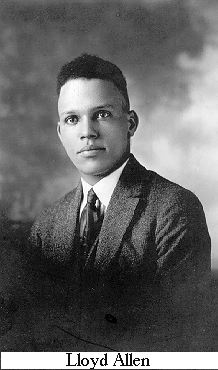 We know little else about him except that he was light brown skinned with "crinkly"
hair, and is remembered as resembling his grandson, Lloyd (son of George Allen III)
in physical type.
We know little else about him except that he was light brown skinned with "crinkly"
hair, and is remembered as resembling his grandson, Lloyd (son of George Allen III)
in physical type.
Those who still remember seemed to see him as "angry
and brooding", a figure whose photograph hung in the parlor of the farmhouse in St.
James. (Does anyone have that picture still?) We know that his death brought little
anguish and some measure of relief (if the stories around this are reliable). He
seems to have left little of himself but a stream of children. George fades into
the background of the remarkable and colorful Leontine.
These facts seems to hold little real truth, though, since there is no accounting
for some interesting anomalies: Why did all of the children speak his language
as their primary tongue? Would this have meant that his influence was greater than
the meager facts would indicate, or, were these such tumultuous times in St. James
that the takeover of Northern (English) culture destroyed everything in its way?
It is hard to imagine how this family—without the benefit of later technological
advances -- radio, video, greater mobility—moved from one language to another
in a single generation. And, in a family where the dominant parent spoke only French,
the language change seems the more dramatic.
We will continue to probe and in time will flesh out more of the truth, I'm sure.
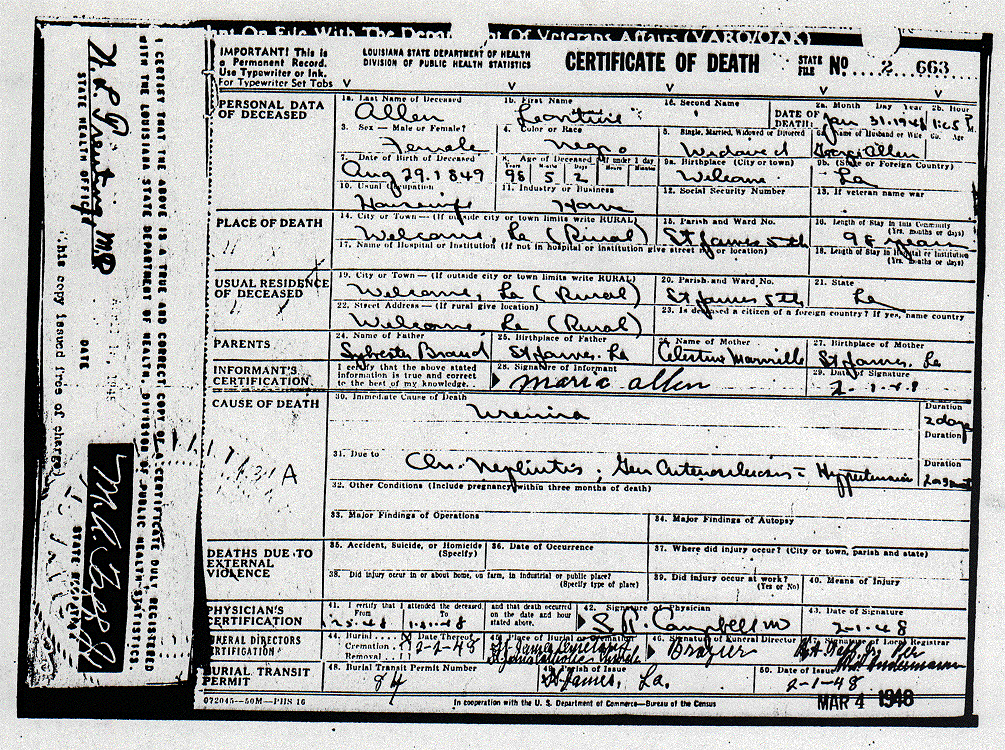
Certificate of Death of Leontine Breaux Allen
January 31, 1948
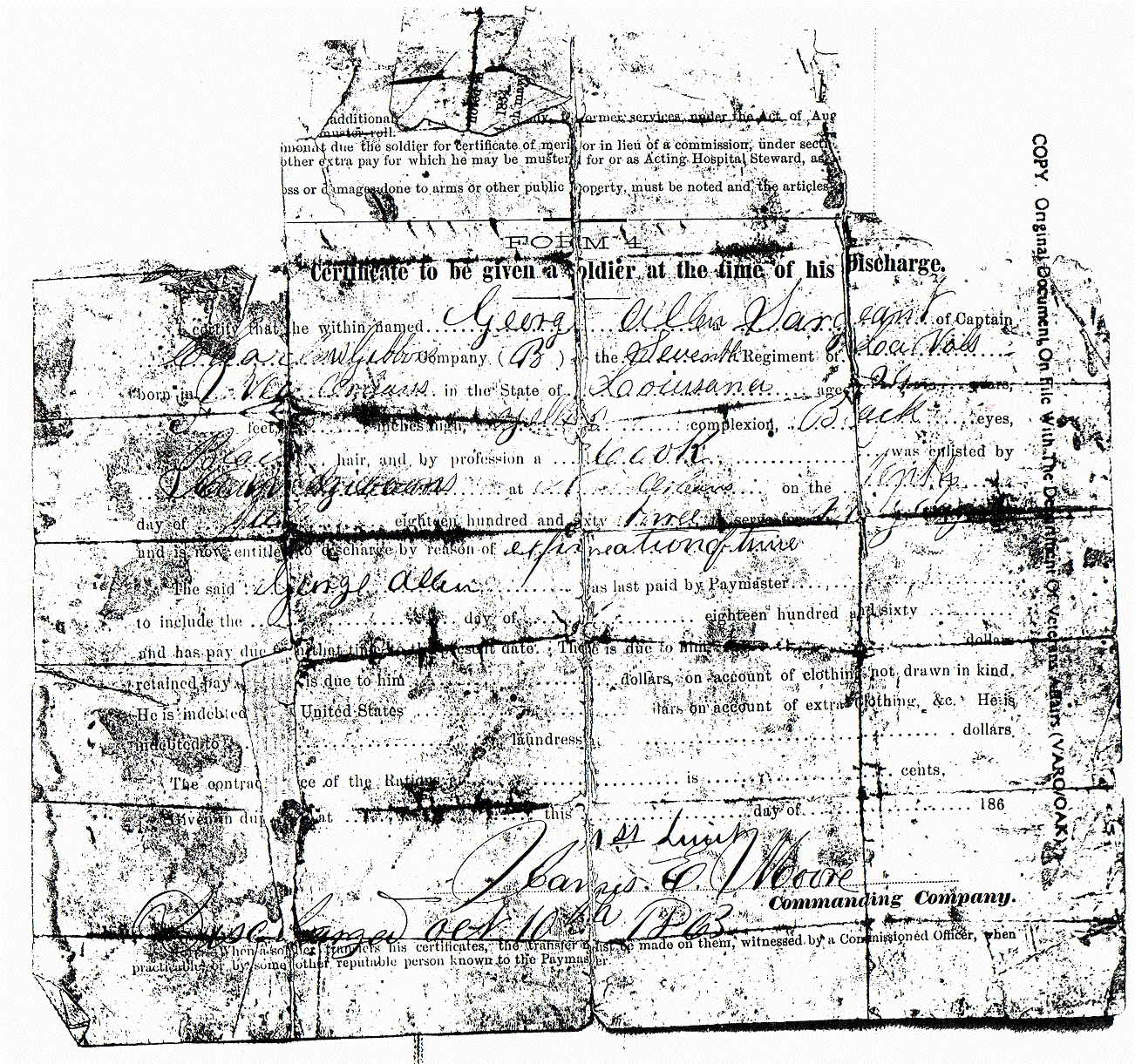
Army Discharge Certificate of George Allen
October 10, 1863
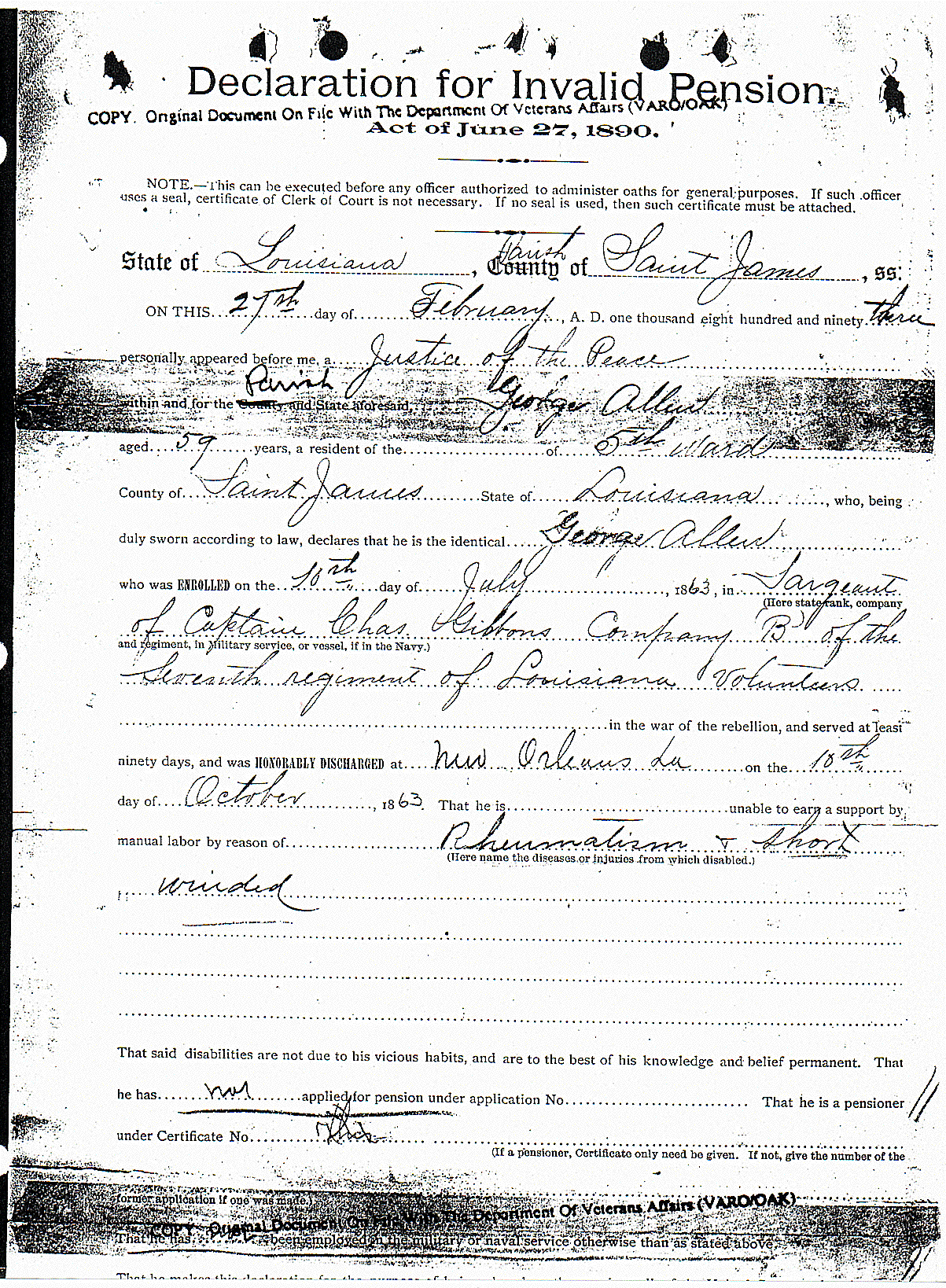
Pension Declaration of George Allen
February 27, 1893
Indicates U.S. Army Service from July 10, 1863 to October 10,
1863
For The Future
(Written, you must remember, in the early 1990's)
The recent acquisition of an old map of Louisiana (courtesy of cousin, Donald Therence,
son of Annabelle LeBeouf and Vernon Therence, Sr.; daughter of Marie Isabelle Allen
LeBeouf Warnie, and—etc., etc., etc.,) suggests that there is still much to explore.
An entirely new approach opened up with a glance or two at the map (appended) since
it is clear that those names of plantation owners in the 1830-50 census microfilms
turn up now to be the names of townships of Louisiana. The evolution is evident.
I can also recall visiting St. James as an adolescent. The Greyhound bus driver used
Mamma's house as the destination. All I had to say was that I was going to
visit "Ma'am George" and the bus stopped next to the levee and in front of her house.
This, then, is the obvious genesis of geographical names and the method by which
they become fixed. See how many familiar names you can find on the map.
We do hope that this early attempt at tracing our genealogy will spark an interest
in others of us so that the youngest family members will gain a sense of being a
part of the continuing family entity which reaches back in time as far as imaginations
will take them. And that they can then project themselves into a future that, together,
we will shape. What wondrous things we mortals
be!
Ruth and I are intrigued enough to have planned another visit to the Mormon Temple
Archives in order to fit even more pieces of this human puzzle together. The Quest
for Allendom has only just begun and is in full progress.
An exciting side trip may well be an exploration of the All-Black town of Allentown
which was established after the Civil War in Central California. Do you suppose ...
?
There are also some interesting "side trip connections" that need exploration:
a) It is rumored that Andrew Young (yes,that Andrew Young) is a member of
the Allen Clan through Aunt "Noon" and Uncle Sam.
b) ...and we all know about the obvious connection between
Louisiana's Senator Breaux? And,
c) hearing some of the family history of Debbie Allen and Phyllicia Rashad suggests
a strong connection through their father who hails from the same general Area of
Louisiana.
This suggests a fertile field of discovery for the next family "sleuth" to explore.
As for me, I've already started work on the Charbonnets whom I discovered in the
Census of 1850 as owning a plantation in St. John The Baptist Parish (right next
door to St. James), et cetera, et cetera, et cetera, . . . .
Most sincerely
Betty Reid Soskin (nee Charbonnet)
©1990
Note: Allendom was originally written for Allen Family Reunion August 7, l990 and revised February 15, 1994. Some of the future work called for in the "For The Future" concluding section has since been completed or is close to being completed, and many things which were mysteries to us in the early and mid 90's have been cleared up and incorporated into our knowledge base of our family history.